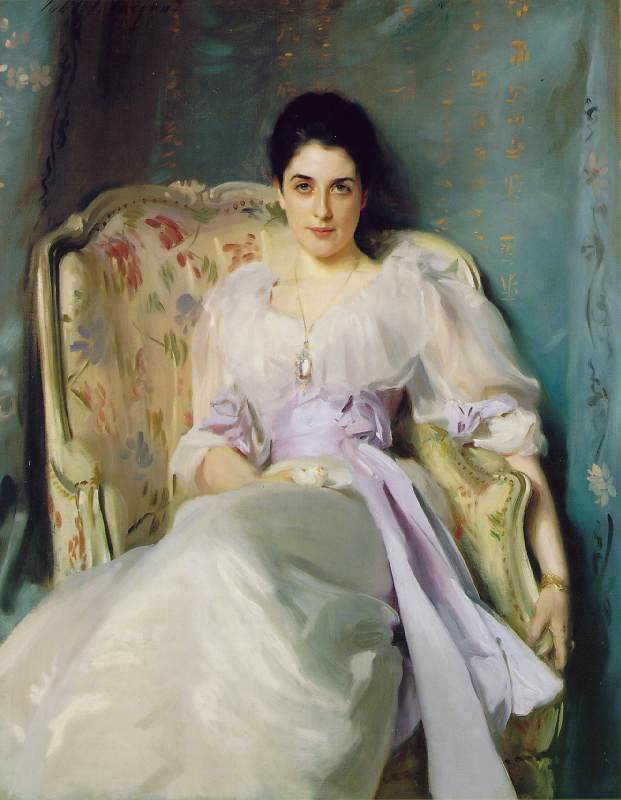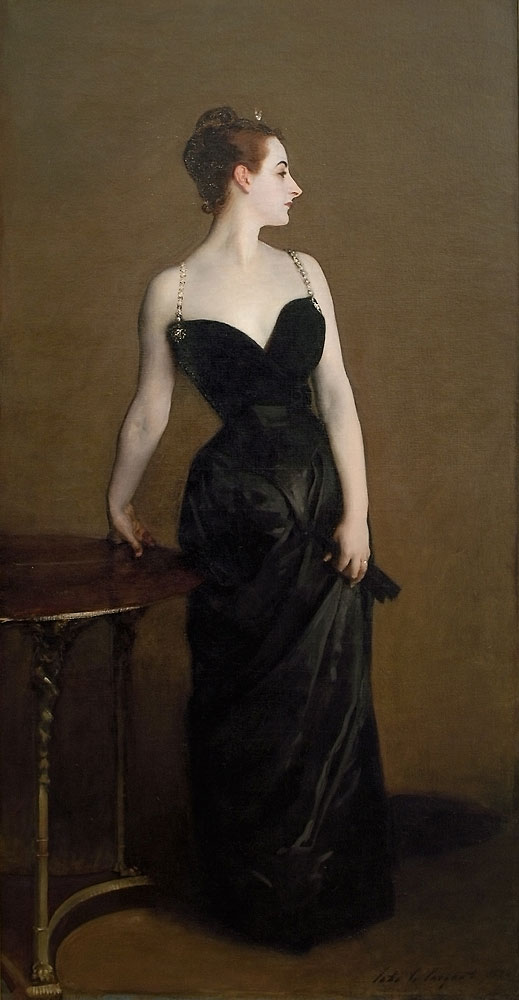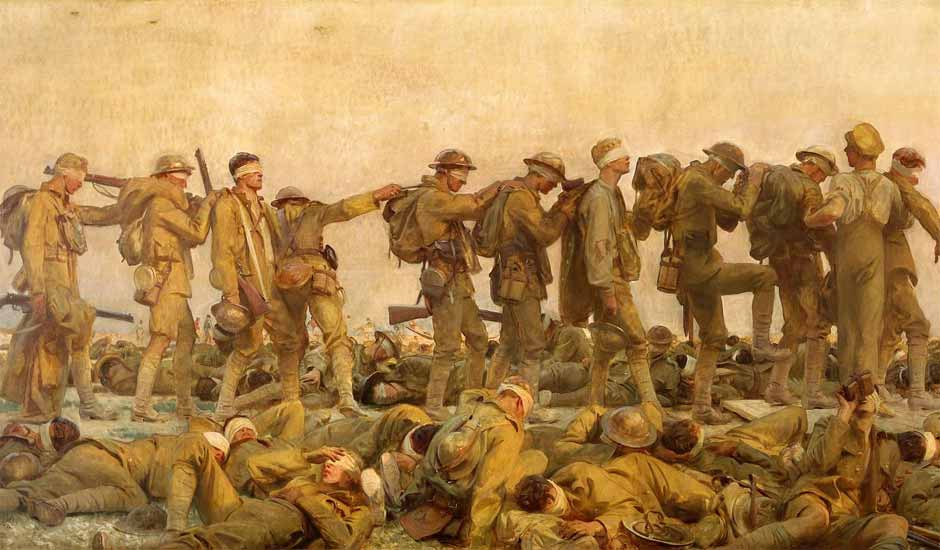Mustn't a portrait painter also be a psychologist? They do not merely paint what they see; they capture the personality of the subject, their essence. If that is the case, I wonder if training in portraiture might enhance the professional performance of clinical psychologists? That, as we say, is an empirical question. (The article below suggests that Sargent was not a brilliant psychologist, but actually rather somewhat autistic.)

Theodore Roosevelt (1903)
"John Sargent was given little regular schooling. As a result of his "Baedeker
education," he learned Italian, French, and German. He studied geography,
arithmetic, reading, and other disciplines under his father's tutelage. He also
became an accomplished pianist. His mother, an amateur artist, encouraged him to
draw, and her wanderlust furnished him with subjects. He enrolled for his
first-documented formal art training during the winter of 1873–74 at the
Accademia di Belle Arti in Florence. In spring 1874, Fitzwilliam Sargent
resolved to nourish his son's talent in Paris, which had become the world's most powerful
magnet for art students." [from metmuseum]

Lady Agnew of Lochnaw (1893)
"Lady Agnew's direct gaze and informal pose, emphasised by the flowing fabric and lilac sash of her dress ensure the portrait's striking impact. Andrew Noel Agnew, a barrister who had inherited the baronetcy and estates of Lochnaw in Galloway, commissioned this painting of his young wife, Gertrude Vernon (1865-1932), in 1892. It was exhibited at the Royal Academy in 1898 and made Sargent's name. The sculptor Rodin described him as 'the Van Dyck of our times'. Portrait commissions poured in and Sargent enjoyed something of a cult following in Edwardian society. It also launched Lady Agnew as a society beauty." [from National Galleries]

Madame X (1884)
"Although Sargent painted, showed, and won praise for both portraits and subject
pictures at the Salons between 1877 and 1882, commissions for portraits
increasingly demanded his attention and defined his reputation. Sargent's
best-known portrait, Madame X (16.53), which he
undertook without a commission, enlisted a palette and brushwork derived from
Velázquez; a profile view that recalls Titian; and an
unmodulated treatment of the face and figure inspired by the style of Édouard Manet and Japanese prints.
The picture's novelty and quality notwithstanding, it was a succès de
scandale in the 1884 Salon, provoking criticism for Sargent's indifference
to conventions of pose, modeling, and treatment of space, even twenty years
after Manet's pioneering efforts."

Gassed [detail] (1919)
The Wall Street Journal has a fantastic weekly feature called "Masterpiece." The entire article on the above work is well worth reading. An excerpt:
"Sargent used the immense width of the canvas to re-create in nearly life-size what he saw at Le Bac-du-Sud. The setting sun is low in the sky as a line of gassed soldiers, their sightless eyes covered by strips of cloth, stumbles toward the dressing station, a tent whose guy ropes are seen at the far right. Each soldier grasps the shoulder of the man in front of him, and most still hold their Enfield rifles and carry their now useless gas masks in canvas bags. More wounded men lie on either side of the duckboard road the blinded men walk.
In the background of Sargent's painting, another line of gassed soldiers lurches diagonally toward the dressing station. The stricken but still upright figures are a strong compositional contrast to the jumble of writhing men awaiting treatment in the dressing station.
But what Sargent records in "Gassed" is paradoxical: Instead of depicting the dreadful toll of mustard gas that he saw with his own eyes on that day in 1918, he paints an elegantly composed scene gilded by the warm summer glow of the setting sun.
Unlike the nihilistic war artists a generation younger than he, Sargent was a Victorian who still saw nobility in war and in the sacrifice it required. His "Gassed" is, accordingly, a masterpiece that dwells between anguish and beauty, a haunting image of human suffering sanctified by his empathetic and elegant brush."
John Singer Sargent

"A Street in Venice" by Sargent. Reed Saxon/Associated Press
Although Americans claim him as part of the national heritage, Sargent was hardly an American, having been born and reared in Europe. His father was a doctor who gave up his comfortable Philadelphia practice to accommodate his wife's wanderlust. They moved around Europe, from one hotel or rented villa to another. Sargent lived everywhere and nowhere until settling in Paris and then, ultimately, in London. He didn't even visit America until he was 21.
Partly this may explain why the artist has always seemed to be observing a world he neither occupied nor chose to judge. His pictures are, in a sense, amoral, which made him the perfect portraitist for the Gilded Age.
He had worked in the Paris studio of the portraitist Carolus-Duran, who provided him with a role model: an artist making a lucrative career between academic orthodoxy and mild radicalism. Carolus-Duran exhorted his students to paint not from drawings, as the academics taught, but directly onto a blank canvas with a loaded brush. The goal was to affect spontaneity and swiftness.
Velazquez, the virtuoso of immediacy, was Carolus-Duran's god, as he became for Sargent and for modernists like Manet. What Carolus-Duran wanted to cultivate in his students was not the same sort of spontaneity that the modernists were aiming at. It had much more to do with pure pyrotechnics. Under Carolus-Duran, Sargent soon mastered the necessary tonal vocabulary and tricks of the wrist. His palette changed in later years, brightening. But the essential qualities of his art — a fluent shorthand and dashing control of light and shadow — were in place by the age of 22.
Sargent's virtue was to encapsulate most precisely the era's operative notion of luxe, which was unapologetic, unreflective, sublimely superficial. He was the gold standard during the Gilded Age. But he invented nothing; he changed nothing.
It has often been pointed out that Sargent, despite his mastery of pictorial artifice and special effects, was rather dull in his personal life. A creature of laborious routine, an awkward conversationalist, he seems to have been basically incurious. Contrary to the cliché, art is rarely a true mirror of an artist's life, and Sargent is further proof.
If he ever had sex with a man or woman, we don't know. He had no obvious political or religious convictions. We know he played the piano and read avidly, but as Richard Ormond, his great-nephew and one of the curators of a 1999 exhibition of Sargent at the National Gallery, writes, he ''remained strangely unworldly, unbusinesslike with money (he often had to ask his patrons if they had paid him), disarmingly naive about events taking place around him and terrified of publicity and notoriety.''
Like the rest of us, artists don't always know what they're best at, and they often want to be known for what they don't do well. Around 1907 Sargent largely gave up portraiture to paint earnest, unmemorable war pictures and bizarre biblical murals for the Boston Public Library, imagining himself as heir to the great public muralists and history painters of the past.
When Sargent died in 1925 at 69, he was still best known for one thing, portraiture. The war had by then changed Europe and made his embrace of the idle rich and their world of leisure and sunshine seem anachronistic; not that the idle rich had disappeared, merely that admiring them so publicly was no longer in good taste. — Michael Kimmelman
Asperger's syndrome, perhaps?
"Asperger's syndrome, perhaps?"
ReplyDeleteInterestingly enough, at short odds of having Asperger's myself though undiagnosed, the two artists (of those I have come across, which is quite a few) that have instantly struck me as remarkable and, for me most interesting, have been Singer-Sargent and Hopper. Reading up on their personal lives, I was shocked at first but am now not the least bit surprised by their autistic tendancies and traits. The same goes for music. There is a very, very profound link here somewhere.